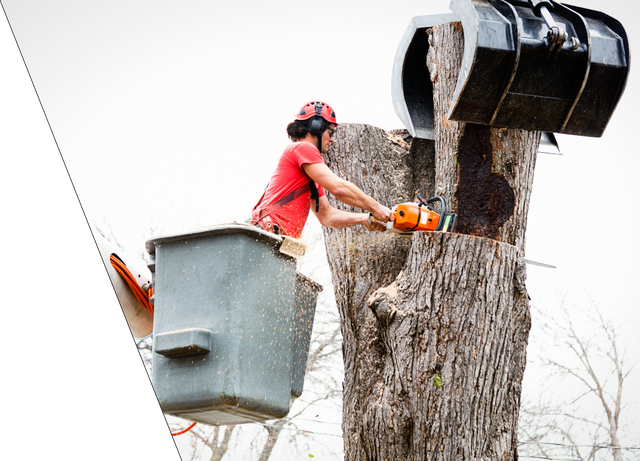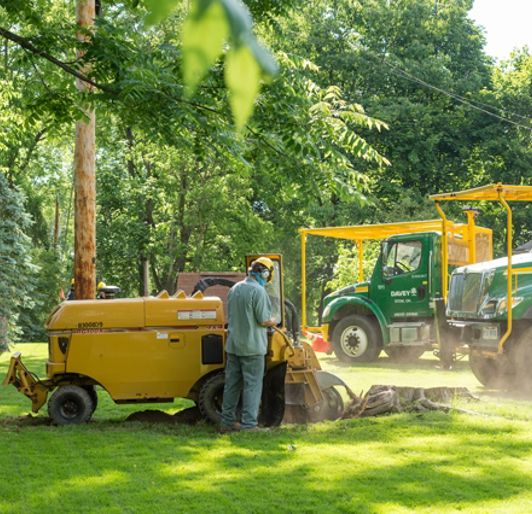The Relevance of Expert Tree Elimination for Protecting Against Prospective Hazards
In today's interconnected landscapes, the importance of professional tree elimination expands past simple looks, offering as an important procedure to prevent potential threats. Educated arborists possess the acumen to determine trees that might compromise safety and security due to degeneration or architectural flaws.
Identifying Hazardous Trees
Identifying dangerous trees is a crucial element of guaranteeing safety in both property and business environments. Trees, while offering ecological and aesthetic advantages, can pose substantial risks if they are structurally unhealthy or endangered. Identifying these trees requires a keen eye for detail and an understanding of different indication that might suggest possible danger.

Root wellness is another important variable; subjected origins, fungal growth around the base, or soil heaving can show instability. In addition, dead or hanging branches, often referred to as "widow-makers," existing immediate threats as they can drop without caution.
Competence in Risk Evaluation
Comprehending the warning indications of harmful trees establishes the stage for educated danger evaluation by specialists. This crucial step requires an extensive assessment of factors such as tree framework, root honesty, and environmental problems. Trained arborists possess the expertise to determine subtle indicators of instability, such as cracks, decay, or leaning, which might not be quickly obvious to the untrained eye. By using rigorous analysis methods, they can properly assess the possible dangers posed by a tree.
Professional arborists are skilled at utilizing advanced tools and techniques, including resistograph examinations and sonic tomography, to examine the interior problem of trees. This scientific method permits a precise understanding of architectural weaknesses or decay, enabling informed decision-making pertaining to tree elimination or other treatments. In addition, their expertise extends to understanding species-specific vulnerabilities, which can affect danger analyses.
Additionally, arborists factor in external components such as dirt conditions, distance to frameworks, and weather impacts, which can intensify a tree's threat account. Their competence guarantees an all natural appraisal, integrating organic, ecological, and situational information to create a comprehensive threat analysis. This careful process is fundamental in making certain and mitigating prospective threats safety and security, underscoring the essential duty of specialist assessment in tree administration.
Safety Methods and Equipment
Safety procedures and tools are extremely important in the professional tree elimination process, ensuring that operations are performed without risk to workers or building. Complying with rigorous safety and security requirements is crucial in mitigating the intrinsic threats related to tree removal tasks. Expert groups are educated to execute extensive precaution, consisting of maintaining a safe and secure border around the worksite to stop unapproved access and potential accidents.
Important tools plays a vital role in guarding tree removal operations. In addition, the usage of setting up tools, such as harnesses, ropes, and sheaves, facilitates controlled tree felling, decreasing threats during the removal process.
Specialist groups are proficient in examining environmental problems, such as climate and terrain, to readjust safety and security measures appropriately. This commitment to safety procedures and tools highlights the competence and diligence of specialist tree elimination services in preventing prospective dangers.

Reducing Property Damage
Usually, lessening residential or commercial property damages is a fundamental objective of specialist tree removal services - Tree removal. The elaborate process of tree removal demands a critical method to guarantee continue reading this that bordering frameworks-- such as homes, garages, fences, and utility lines-- stay unharmed. Expert arborists possess the know-how to evaluate the tree's problem and its closeness to potential hazards, employing innovative strategies to reduce threats
One vital component is the execution of specific cutting approaches, which needs an eager understanding of tree physics and structural honesty. Experts utilize regulated felling strategies to direct the tree's fall Visit This Link path, dramatically decreasing the chance of civilian casualties. Additionally, using customized equipment, such as cranes and setting up systems, permits for the risk-free dismantling of precariously located or big trees in constrained rooms.
Moreover, skilled tree removal experts perform comprehensive website analyses to identify and address any underlying concerns that could add to residential property damages, such as root invasion or dirt instability. This proactive method ensures that the removal process is carried out with minimal disturbance to the existing landscape, guarding both the building and its visual value. By leaving tree removal to specialists, property proprietors can feel confident that every precaution is taken to secure their investment.

Long-Term Health And Wellness of Your Landscape
In the context of professional tree removal, securing residential or commercial property is carefully connected to promoting the lasting wellness of your landscape. Trees, while useful properties to any kind of residential or commercial property, can likewise become liabilities if not effectively preserved - Tree removal. Unhealthy, harmed, or improperly put trees can compromise the integrity of your landscape, affecting soil wellness, taking on various other greenery for resources, and possibly leading to the spread of bugs and illness
Professional tree elimination ensures that just those trees that position a threat to your landscape's health are gotten rid of, consequently imp source receiving the vitality of the remaining flora. Specialists evaluate each tree's problem and its connection with the surrounding atmosphere, considering factors such as origin spread, canopy coverage, and distance to various other plants. By eliminating trees that are exceedingly competitive or harmful, experts help create a balanced ecosystem where all elements of your landscape can grow.
In addition, the elimination process itself is conducted with accuracy, decreasing damages to the surrounding area. This mindful technique protects dirt structure and prevents unneeded disturbance to the root systems of nearby plants. Ultimately, expert tree elimination adds to a much healthier, much more resilient landscape, ensuring its appeal and performance for years to come.
Conclusion
Expert tree elimination plays a crucial duty in maintaining safety and ecological wellness. By determining unsafe trees and utilizing know-how in risk evaluation, educated arborists properly prevent prospective dangers associated with structurally unstable trees.
In today's interconnected landscapes, the value of professional tree removal expands beyond mere aesthetics, offering as a crucial measure to avert possible risks.Security procedures and devices are extremely important in the specialist tree elimination procedure, making certain that operations are conducted without danger to workers or property.Specialist tree elimination makes certain that just those trees that posture a risk to your landscape's health are eliminated, consequently sustaining the vitality of the continuing to be vegetation.Professional tree elimination plays an essential role in keeping safety and security and ecological wellness. By using and identifying unsafe trees proficiency in threat evaluation, trained arborists successfully protect against potential threats linked with structurally unstable trees.